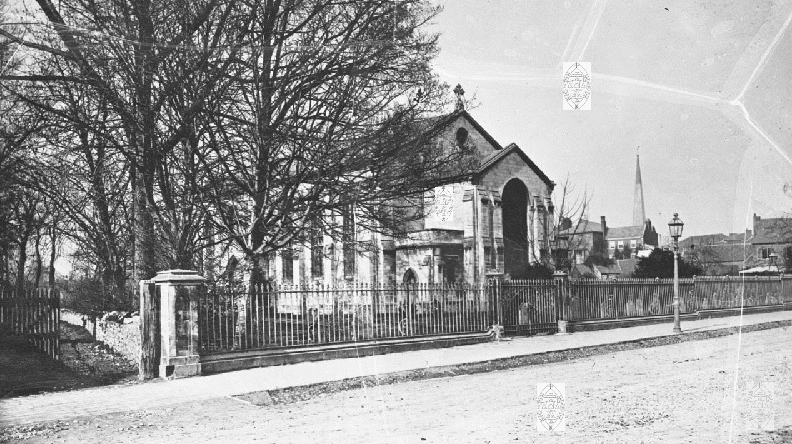
©digital image 2009 Blake Museum PR56 All rights reserved
Holy Trinity Church was located on the area of empty ground near the junction of Taunton Road and the Broadway. All that remains today are the old boundary walls and a handful of neglected tombstones.
In the early 1830s it was noted that the ancient medieval parish church of St. Mary’s was not large enough to service the population of the growing town. One of the churchwardens at the time estimated Bridgwater had a population of around 2000 families, yet the church had a mere 200 seats. The options suggested to remedy this were to either construct a gallery within St Mary’s, or else to build a whole new church. The latter option was chosen, although the project stalled for a number of years as funds could not be put together until 1839. One of the principal patrons of the church building was Ruscombe Poole and his daughter laid the foundation stone. The church was designedby Richard Carver, a prolific Somerset architect, who also designed the town hall, the town gaol and the county court in Queen Street, the builder was Thomas Hutchings. The first vicar was James Wollen, who was son of the Vicar of St Mary’s. Holy Trinity was at first a district church of the parish of St. Mary’s, but in 1856 it was made a separate parish. Initially the church yard consecrated for burials and 79 were interred there, but this was ordered to stop in 1853. Thereafter the congregation had to be buried in the Wembdon Road Cemetery. However as this was the property of St. Mary’s and the vicar of Holy Trinity had to ask for permission to perform services there.
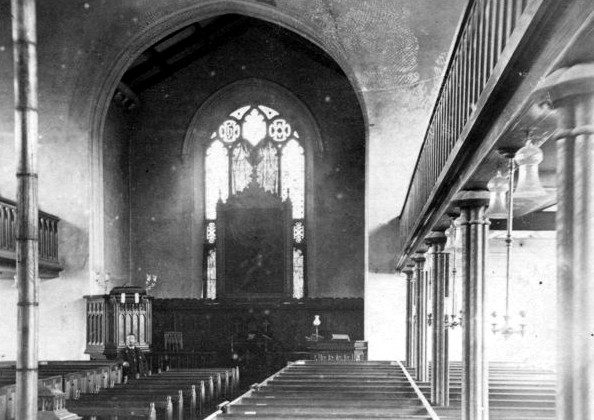
©digital image 2012 Blake Museum 57D All rights reserved
By 1870 Holy Trinity had fallen on hard times, the congregation had dwindled to about a dozen, the building was in poor state of repairs and the gas was cut off. In 1874 the new vicar, George Trevor set about to reverse this decline and the building was thoroughly restored in 1876, with a capacity of 850 seats. Trevor also managed to accumulate the funds to build a vicarage next door, which stands to this day.
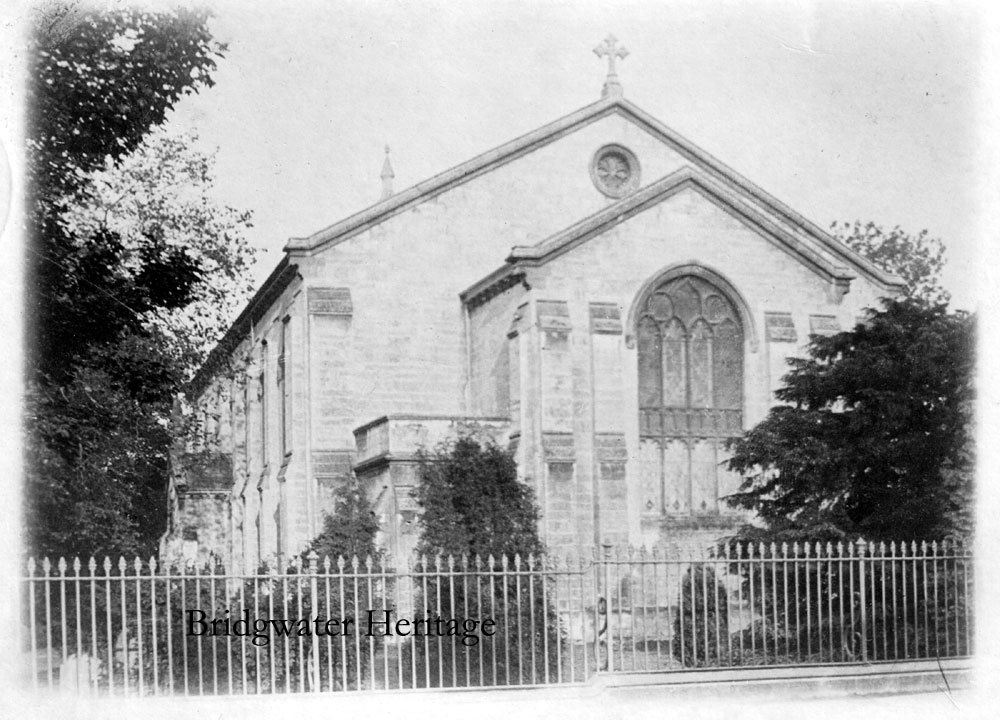
In December 1863 there were fears the gallery in Holy Trinity Church was in danger of collapsing, after creaking heard during service caused members of the congregation to panic. Thomas Hutchings was called in and he found that the side walls were no longer on the perpendicular. He recommended iron bars be run through the church to pull it back into shape. Subsequent investigation by a committee found two joists under the false floor of the gallery were insufficiently supported (Bridgwater Mercury 1 December 1863).
In 1889 Jarman summarises the building of Holy Trinity as such: ‘it is difficult to describe the architecture of Holy Trinity -nondescript is perhaps the most correct term… spacious and comfortably seated building, its acoustic properties are good. In outward appearance it is plain and unpretending.’
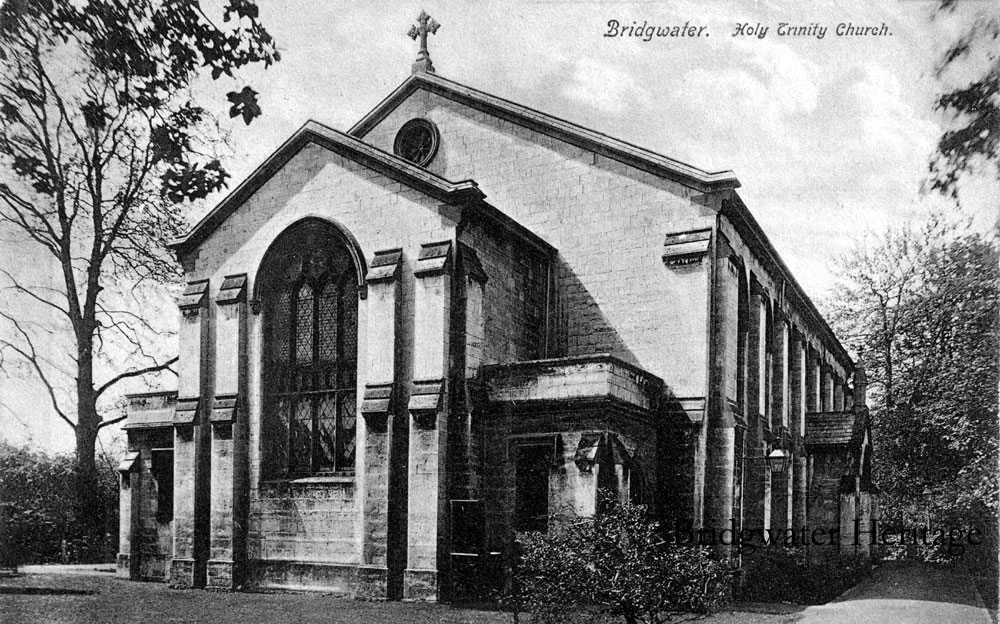
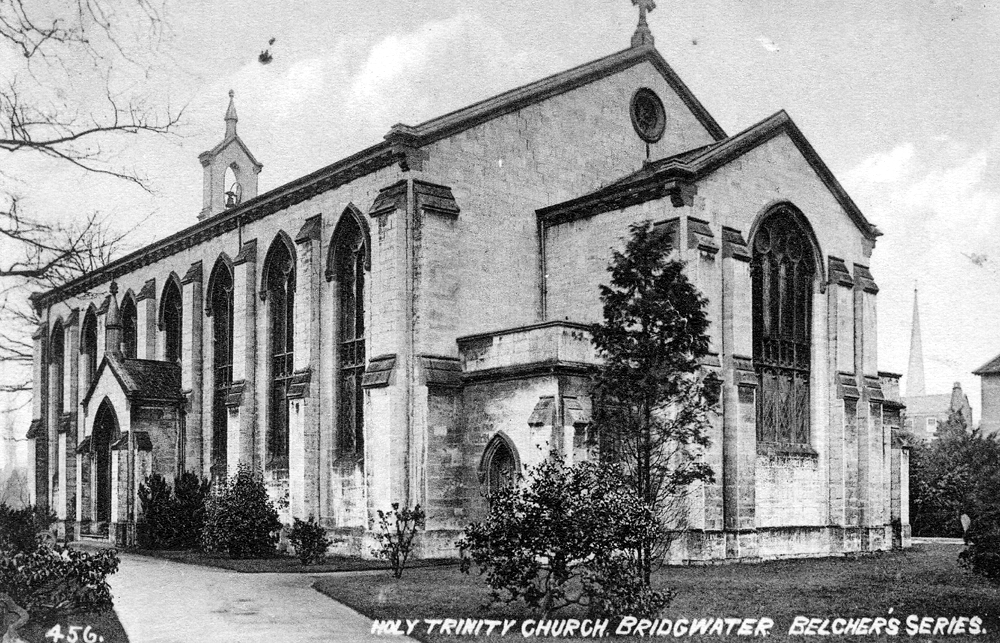
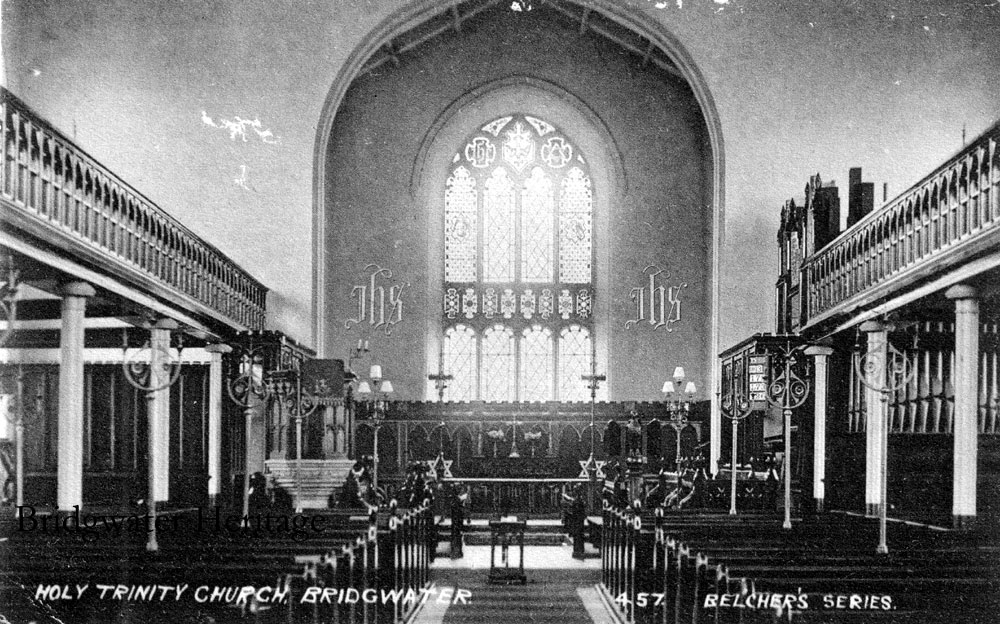
In 1914 the east window of the chancel was rebuilt, and a new stained glass window installed. The Western Daily Press of 2 February 1914 described it thus:
HOLY TRINITY CHURCH, BRIDGWATERThe East window of this church has just been fitted with stained glass, which was yesterday dedicatedby the Bishop of Bath and Wells. The window consists of four lights and tracery, and the subject represented is “The Resurrection Morn.” The dominating figure is the Angel Messenger, who, seated at the entrance to the rock-hewn tomb, with arm upraised, is announcing to the Holy Women the joyous Easter message: “He is not here, for He is risen, as He said. Come see the place where the Lord lay.” The colouring throughout the window, as befits the subject, is soft and subdued in tone. The quiet and carefully blended shades of blue and purple in the robes of the Holy Women the soft tints of the foliage, the neutral tones in the rock work of the tomb, and the grey sky of dawn are all subservient to the rich ruby wings and the pale garments of the Angel. A distant view of the hill of Calvary, with the three crosses outlined thereon, the scattered grave clothes, and the box of precious ointment are amongst the details which add interest and refinement. The window was executed by Messrs Joseph Bell and son, at their studio at 12, College Green, Bristol, under the supervision of Mr P Hartland Thomas, diocesan surveyor for Bath and Wells. The work is undoubtedly a very handsome addition to the church.
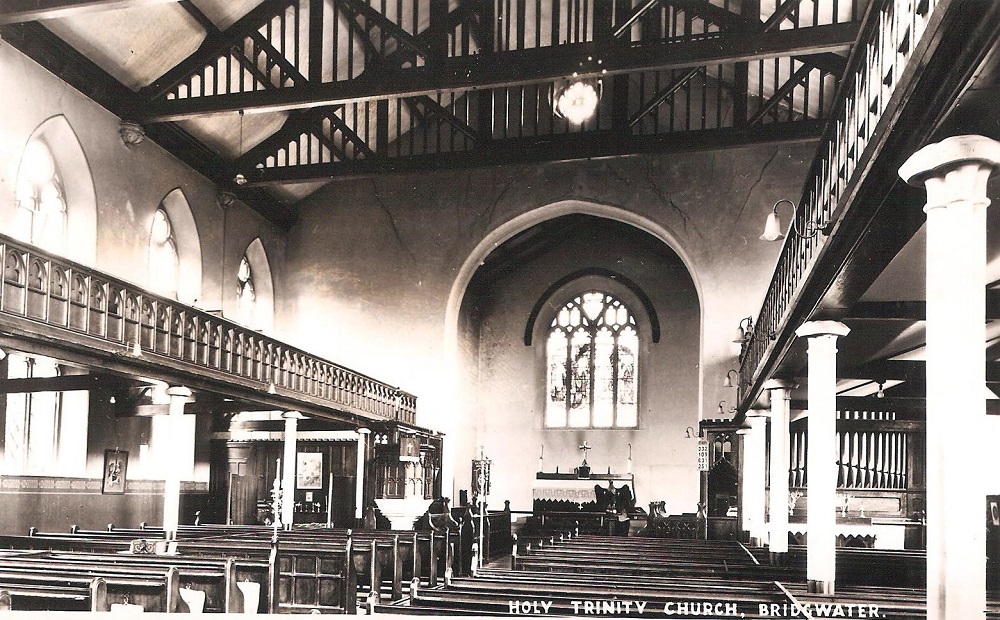
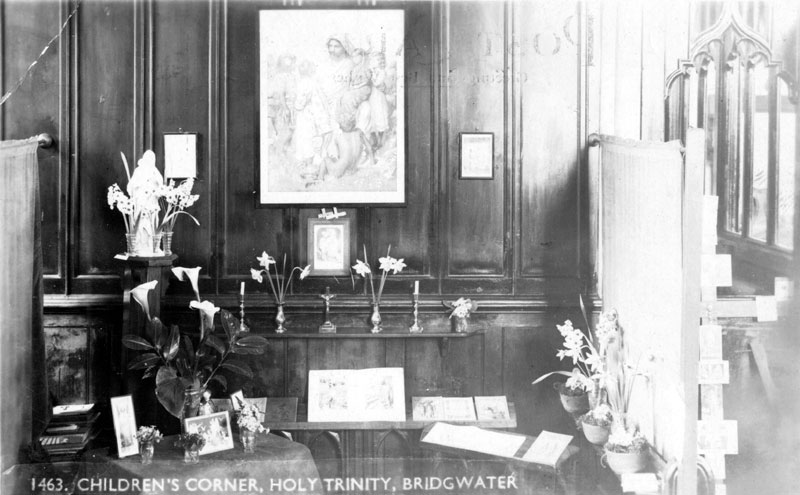
The church was closed in 1958, the decision to demolish taken by the diocese in January, confirmed in April and last service held on 4 May (Taunton Courier and Western Advertiser 4 January 1958; Taunton Courier and Western Advertiser 26 April 1958). The building stood empty for a few years, before its demolition in the summer of 1963: the Bridgwater Mercury for 2nd June that year shows a photograph of the near completion of the demolition. Contrary to the local tale, it was not demolished to make way for the new Broadway bypass, but because the building was too far from the new Hamp Estate for which it primarily served.
At Hamp a chapel of ease was set up in Greenfield House, where the new church would be built. The vicarage was sold in 1960 and is currently the HQ of the County Dental service. A new church, the current Holy Trinity, was built in Hamp, construction starting in July 1959 and completed in September 1961 (Taunton Courier and Western Advertiser 23 September 1961).
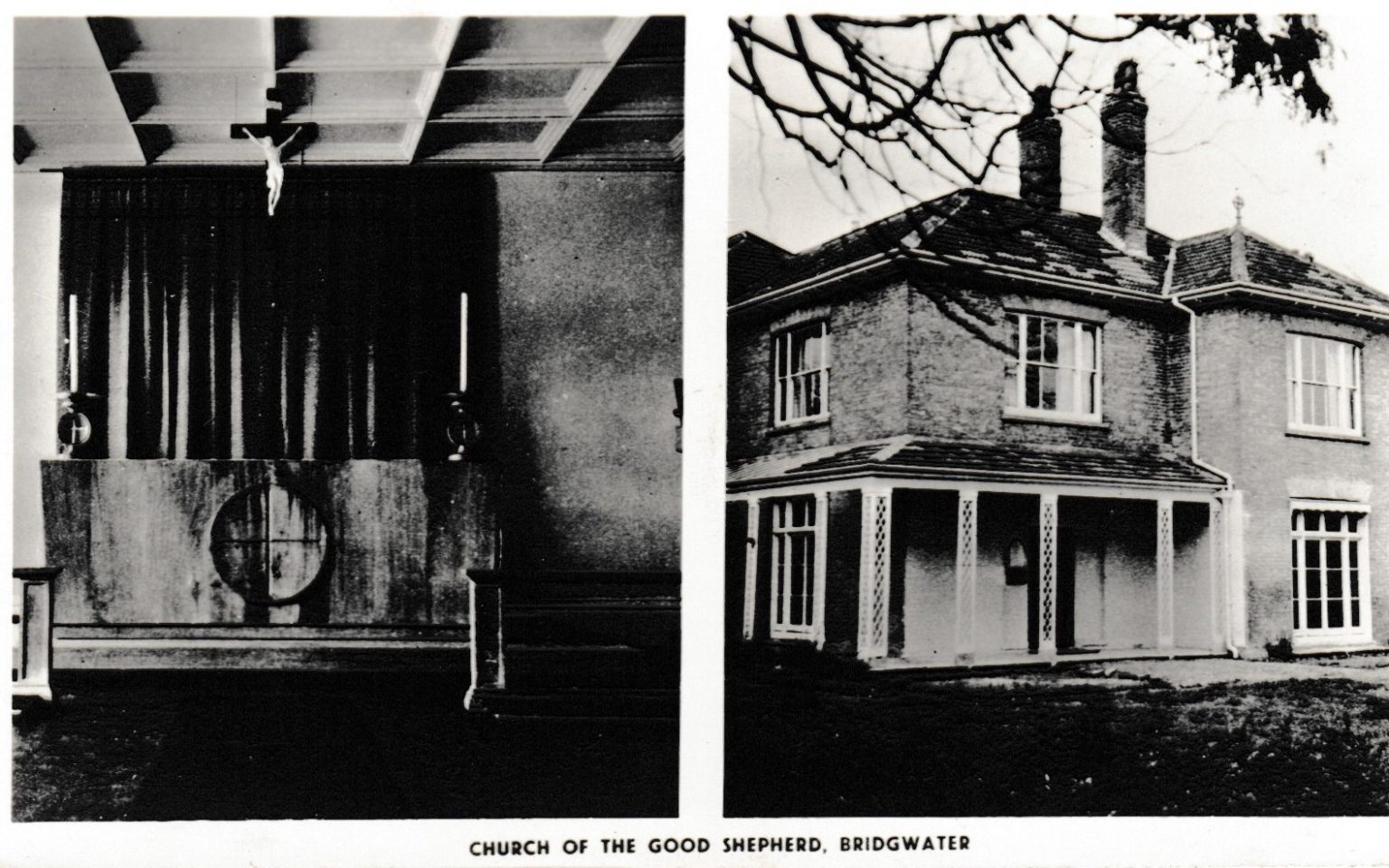
The initial plan was for materials from the old Holy Trinity to be salvaged and built into the new, but in the event the new church was built before the old was taken down.
.
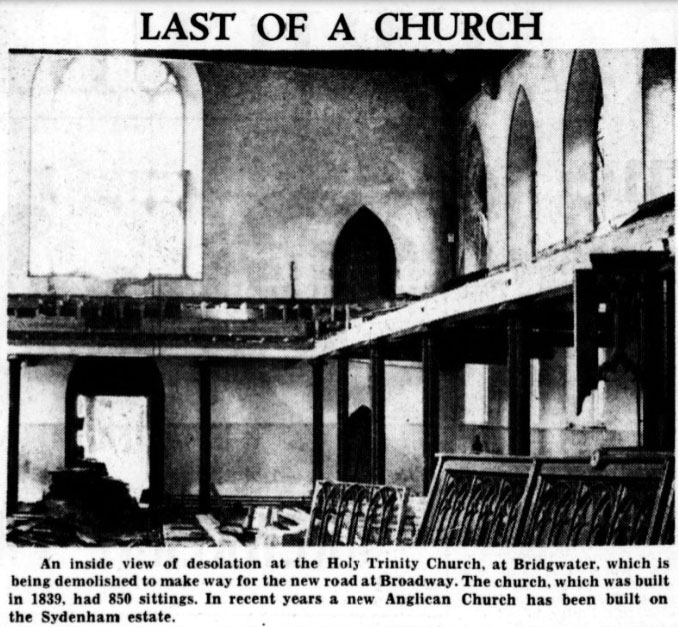
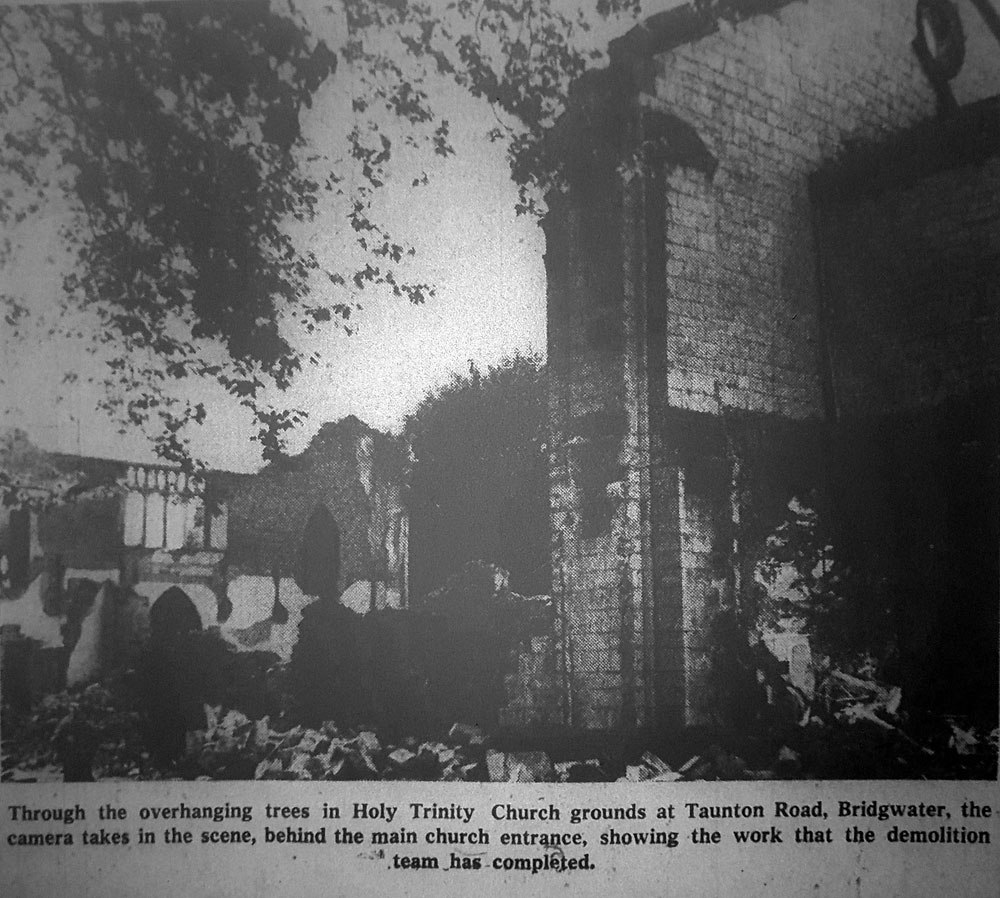
What happened to the rich stained glass is unknown – hopefully it survives somewhere and was not needlessly destroyed. The organ was removed to the new church in Hamp (Taunton Courier and Western Advertiser 23 September 1961). The font of this church was taken to Holy Trinity in Taunton, where it became a holy water stoup in the porch. As an aside, as Holy Trinity Taunton was also designed by Carver and built a little after (1842) its namesake in Bridgwater, it is perhaps no surprise that certain elements, such as the gallery, roof and shallow chancel closely match.
A civic centre was planned for the church site, but nothing came of the plans (Taunton Courier and Western Advertiser 5 March 1960)
MKP. Additional notes by Mike Searle 10 May 2022.
Who built Holy Trinity Church?
Taunton Courier and Western Advertiser Saturday 29 July 1939
Ex-curate’s return for centenary
The Reverend R Turner ( vicar of Holy Trinity, Bridgwater), in a talk to members of Bridgwater Rotary Club, gave many humorous anecdotes on the history of the church.
In a town like Bridgwater, he said, all the text books of history must, of necessity, be focused upon the old parish church. However, Holy Trinity did claim one thing which St Marys could not, the kneelers in the pews were used in Westminster Abbey on the occasion of the king’s coronation
“Religious” Parish.
That part of Bridgwater (continued the vicar) which was in Holy Trinity parish had always been the most religious part of the town. In the Middle Ages a large part of the town was through Grey Friars and there seems to have been a chantry of some sort in Saint Saviours Avenue. Later the denominations began to arrive, and they all settled in this part of Bridgwater, beginning by the river the Roman Catholics have their church in Binford Place, the Wesleyans in King Street, the Congregationalists in Fore St, the Baptists in St Mary’s Street, the Friends, the Brethren, the Christian Scientists, and the Salvation Army in Friarn Street, and most remarkable of all, ever since the vicars of St Mary’s gave up living in their old Vicarage, they had all lived in Holy Trinity parish. (laughter).
St Mary’s Too Full.
The idea of building Holy Trinity Church seemed to have started in 1830. Not from the house-going parson, but from the church-going people. They complained that there was not room for them in St Mary’s church, and they told the bishop that there were 2000 families, he presumed church people, in Bridgwater, and there were not room for more than two hundred of these families in the old parish church. When the mayor and corporation and his chaplain came to Holy Trinity early this month Preb. Hughes-Davies told them how that he had been looking up the records of his church, and there found the account of a rowdy meeting held to consider the question of providing more accommodation. Some of the people wanted to build a new church, and others wanted to build galleries in St Marys. He wondered what would have happened if the people who come to restore St Mary’s found that beautiful church filled up with galleries. About the time of which he had been speaking people all over the country were squabbling about their seats in the churches, and there seemed to have been a wave of church building. Those new churches, all bought an extraordinary family likenesses, and many of them were called Holy Trinity.
Who was the Builder?
Who was responsible for building the Bridgwater Holy Trinity Church, and probably that at Newton and Northmoor Green? Jarman’s history of Bridgwater said the builder was his own architect, and that his name was Carver. Recently, the vicar added, he met an old gentleman on Taunton Road, and asked him who built Holy Trinity Church. The old gentleman replaied, ‘it was my wife’s grandfather whose name was Thomas Hutchings,’ so that it would seem that Jarman was weong. Hutchings was a familiar name in the Moorland district. When they built Holy Trinity Church they built it to contain the very remarkable number of 1,093 people. The organ was in the gallery and there was a good deal of furniture which had long since perished, including quite a different pulpit to the one there today.
Many ups and downs
The church was in use in 1839, the plate was given in 1840, and the registers began in 1841, and yet Jarman said it was not a parish until 1856. “I think”, said the vicar, he is made a mistake. I am credibly informed that the first woman to be married in Holy Trinity Church was the last one to be publicly executed in Taunton (laughter). Holy Trinity settled down and carried on its parish work until the present day. It seemed to have had a great many ups and downs. Nobody knew why they built it exactly where they did. The boundary of the parish extended from the bridge almost up to Durleigh, and yet the church was unaccountably put near St Mary’s.
The golden age
Holy Trinity’s golden age was in the reign of the Rev. George Trevor, who came in 1876 and stayed until 1904. When the Mayor and Corporation accepted his (the speaker’s) invitation to attend a service at Holy Trinity it was stated that that was the first time there had been a civic visit to the church for nearly 60 years, but he had since been told that they came there during the mayoralty of Alderman HW Pollard in the 90s. They knew they came in 1875 to assist in the raising the funds to build the Vicarage. A few weeks ago a former curate, Canon Waller, who married the daughter of the reverend George Trevor, came to preach at the church and after the service Mr and Mrs Waller held a little reception on the Vicarage lawn, where they met many of the older worshipers at the church who they knew, and Mrs Waller, said she remembered laying the foundation stone of the Vicarage.
During the incumbency of Rev George Trevor, Holy Trinity, had then as had now, a band of zealous helpers and on one occasion they set to work to clear away the old pews, put the organ down in the chancel, put in a new pulpiit, and to clean and redecorate the church. Unfortunately they seemed to have mixed the varnish on the pews too thickly with the result that a young man wearing a pair of flannel trousers, after sitting in one of the pews, left a portion of the garment behind him. It was said by someone that at Holy Trinity they not only had no difficulty in getting people to come to church, but they stuck there (laughter).
Former Curates
One of the things they were now doing to mark the centenary was to ask all their ex-curates to preach; There were no ex-vicars living, so he could claim to be the only living incumbent of Holy Trinity. The ex-curates had all had livings, and at least one became a Canon. After the reverend George Trevor they had as vicar a big sturdy Yorkshire man, named Bolland. The next vicar was the Rev E. de Ste. Croix, who was the first to have no curate at all, and in this respect he (the speaker) had followed his example.
Thanks to the speaker were expressed by past president F.P. Tyrell. Rotarian G.S. Heaven presided.
Sources
- Jarman’s History of Bridgwater (1889)
- Squibbs’ History of Bridgwater (1982)
- Bridgwater Mercury 2 June 1963
- Western Daily Press 2 February 1914
